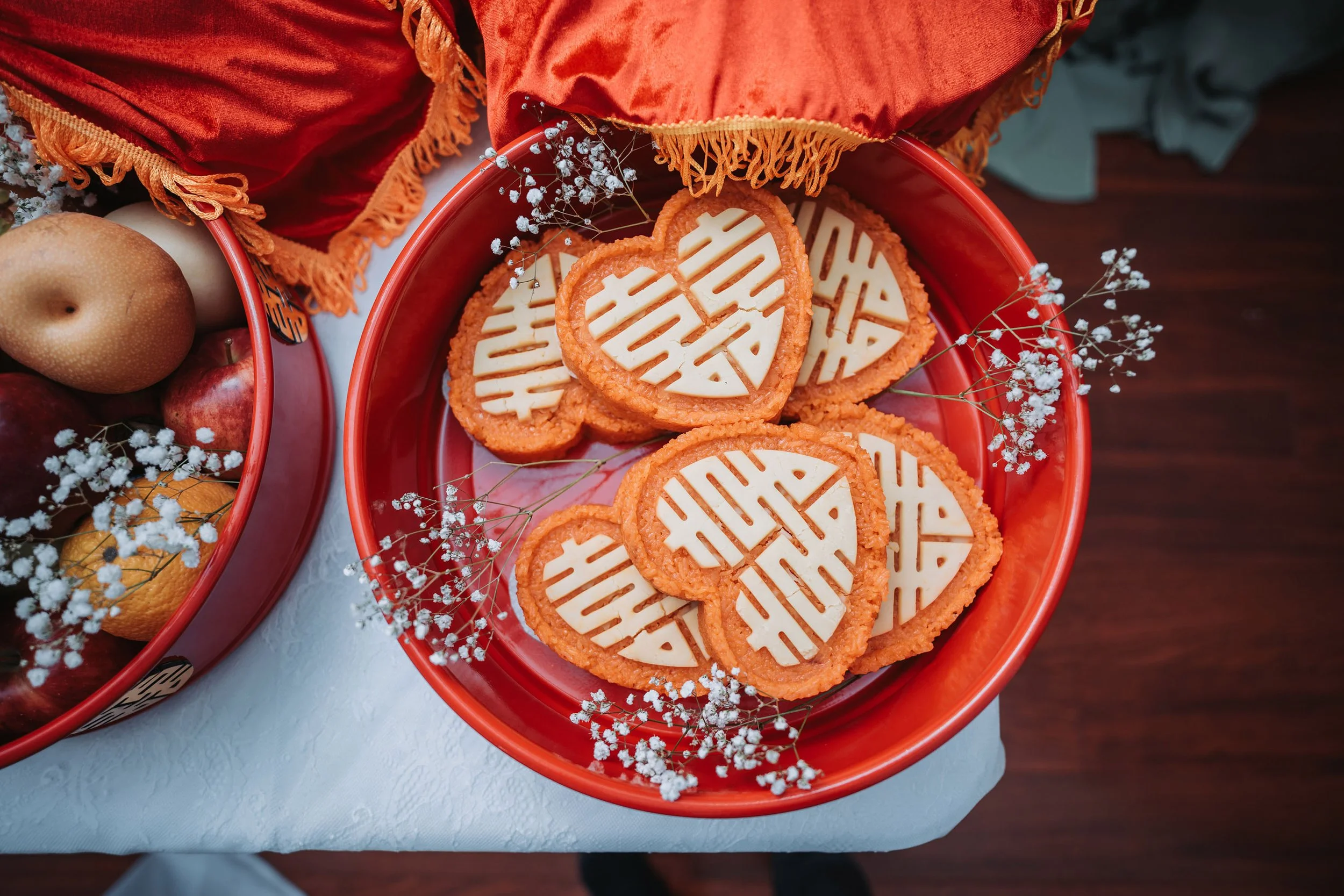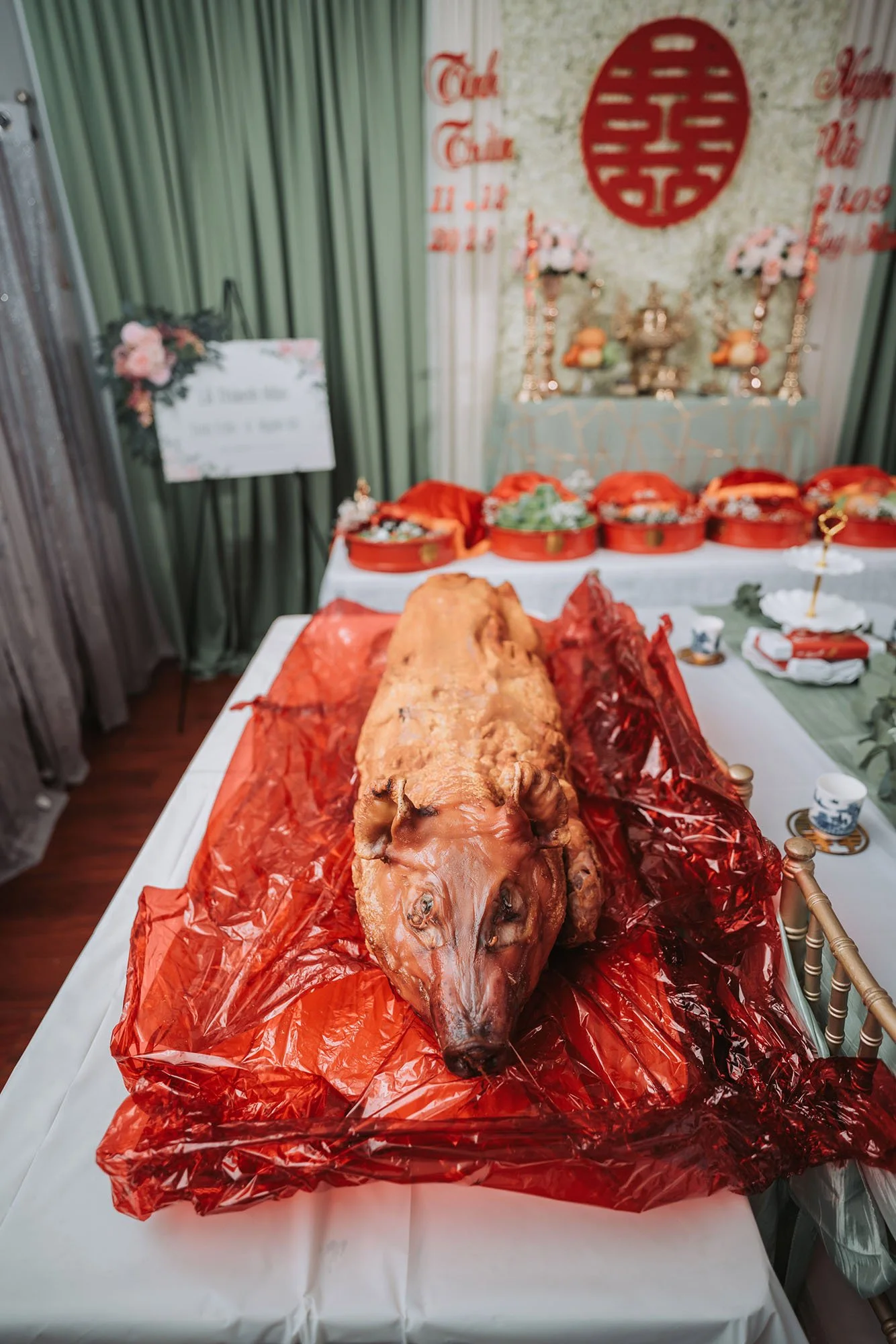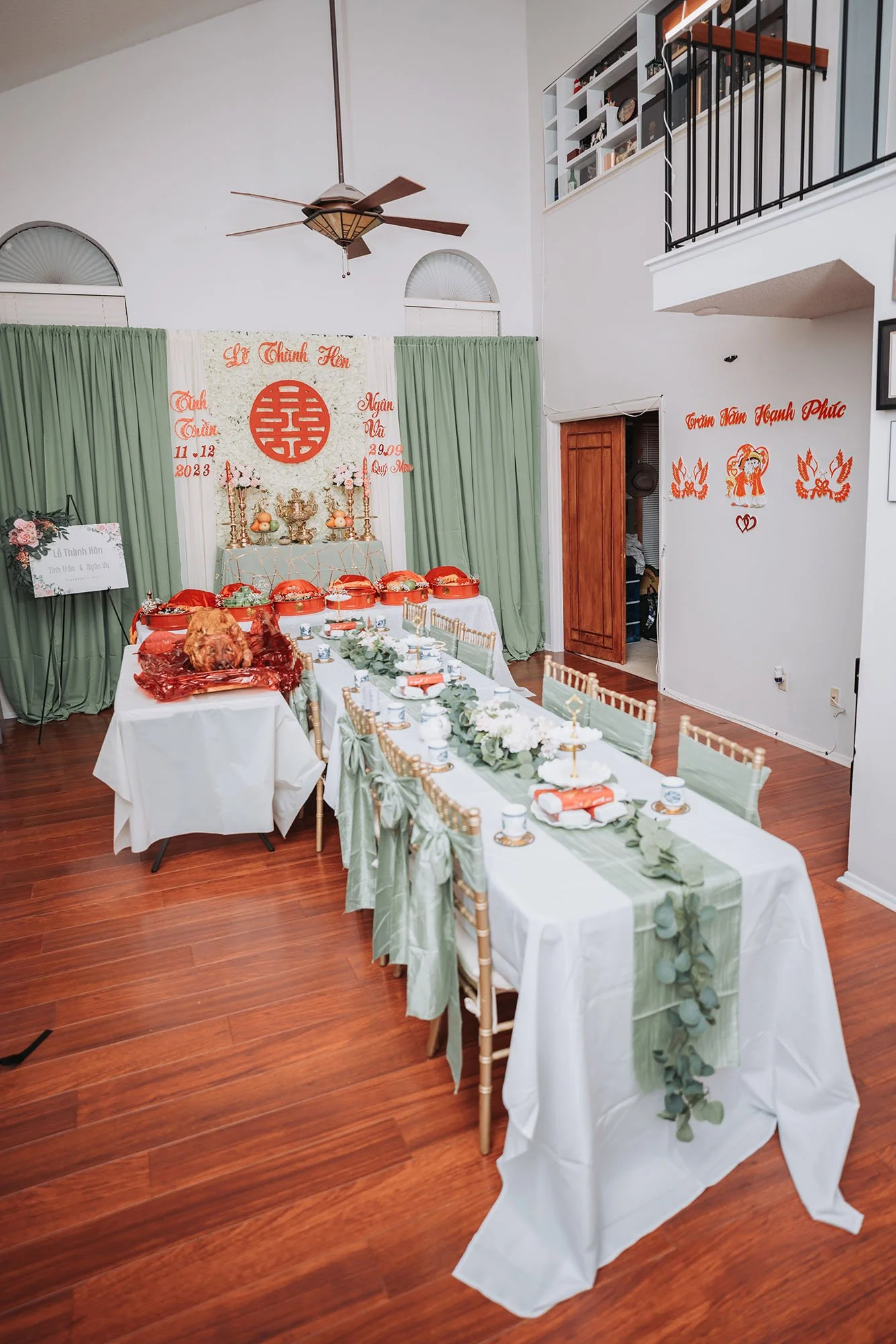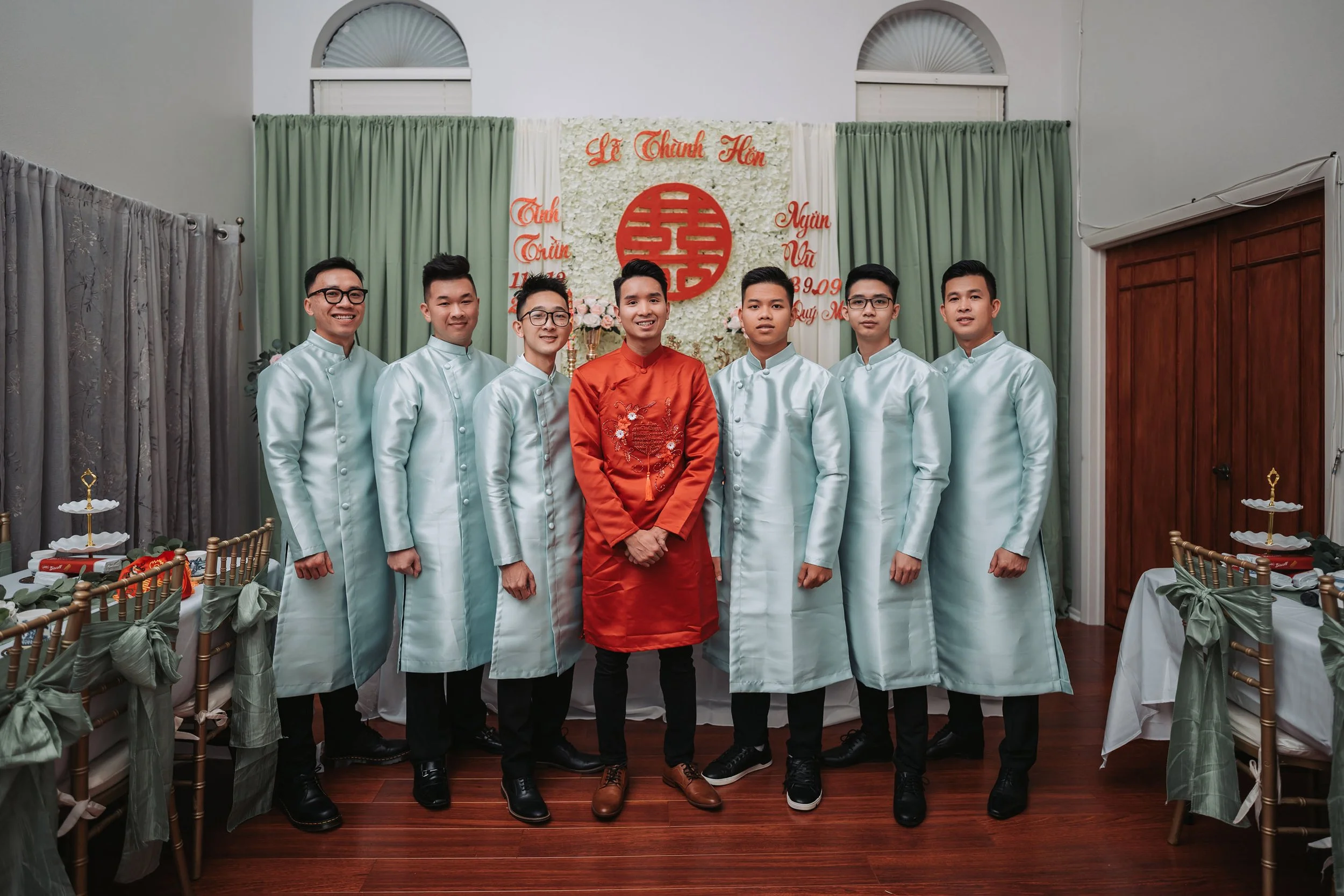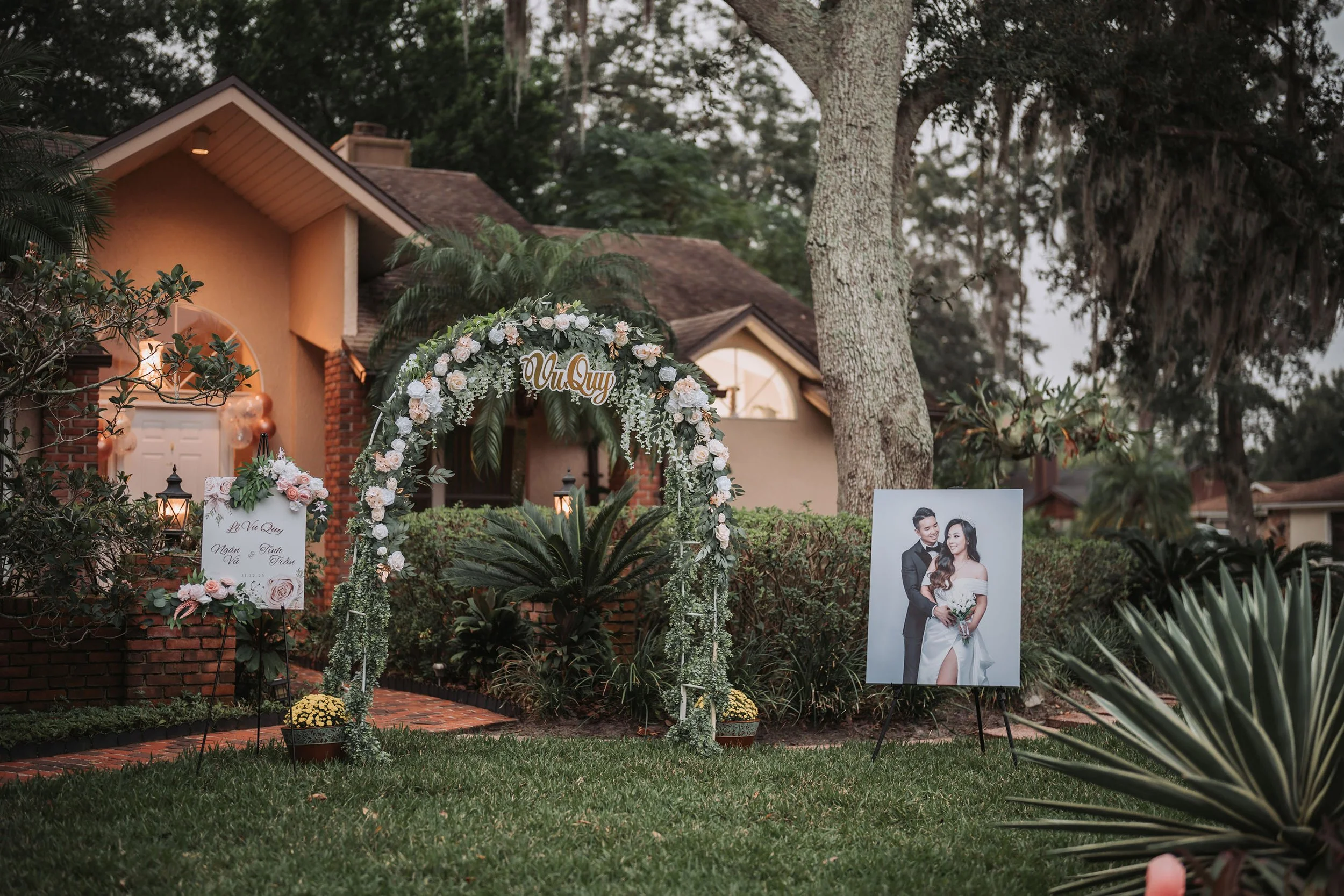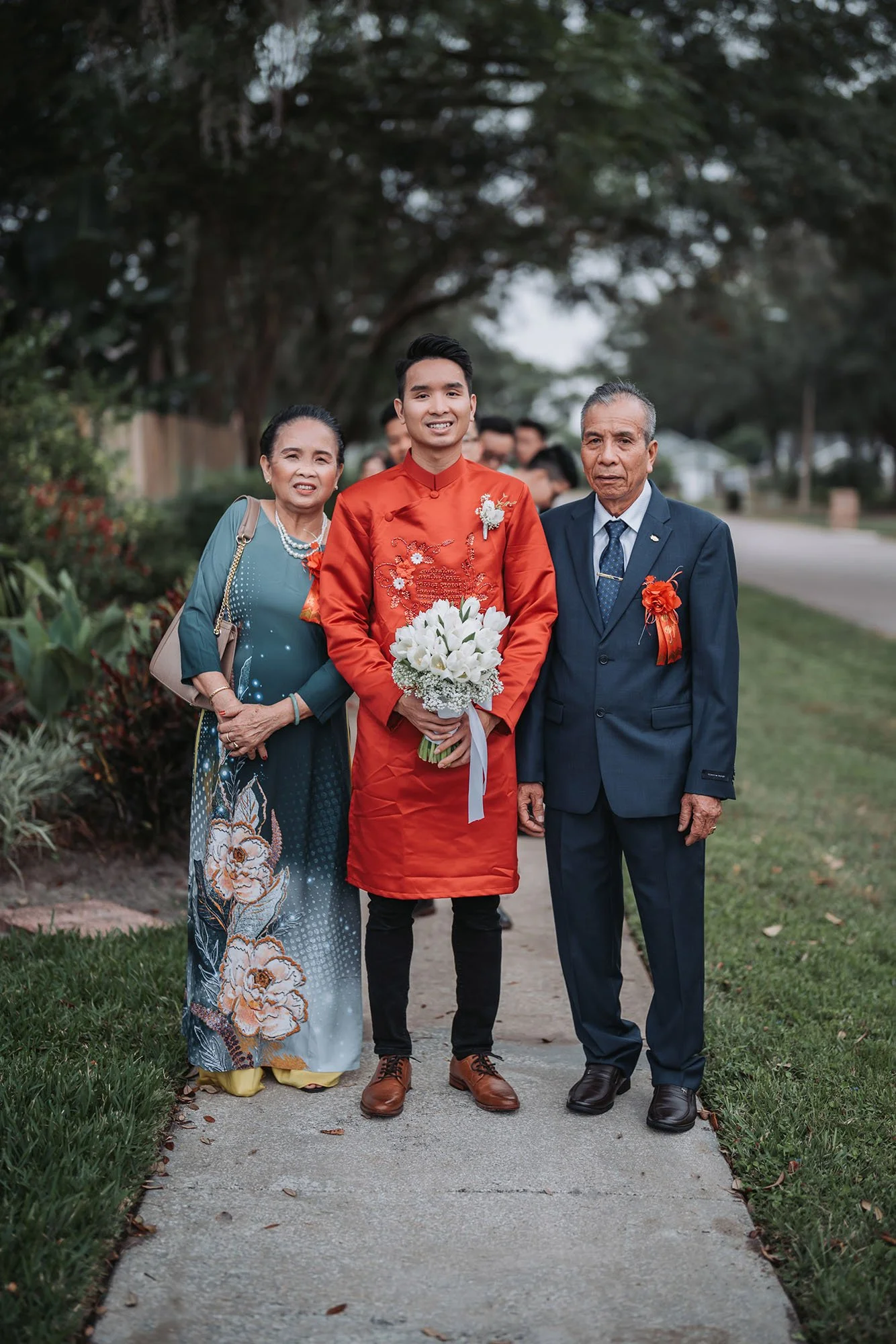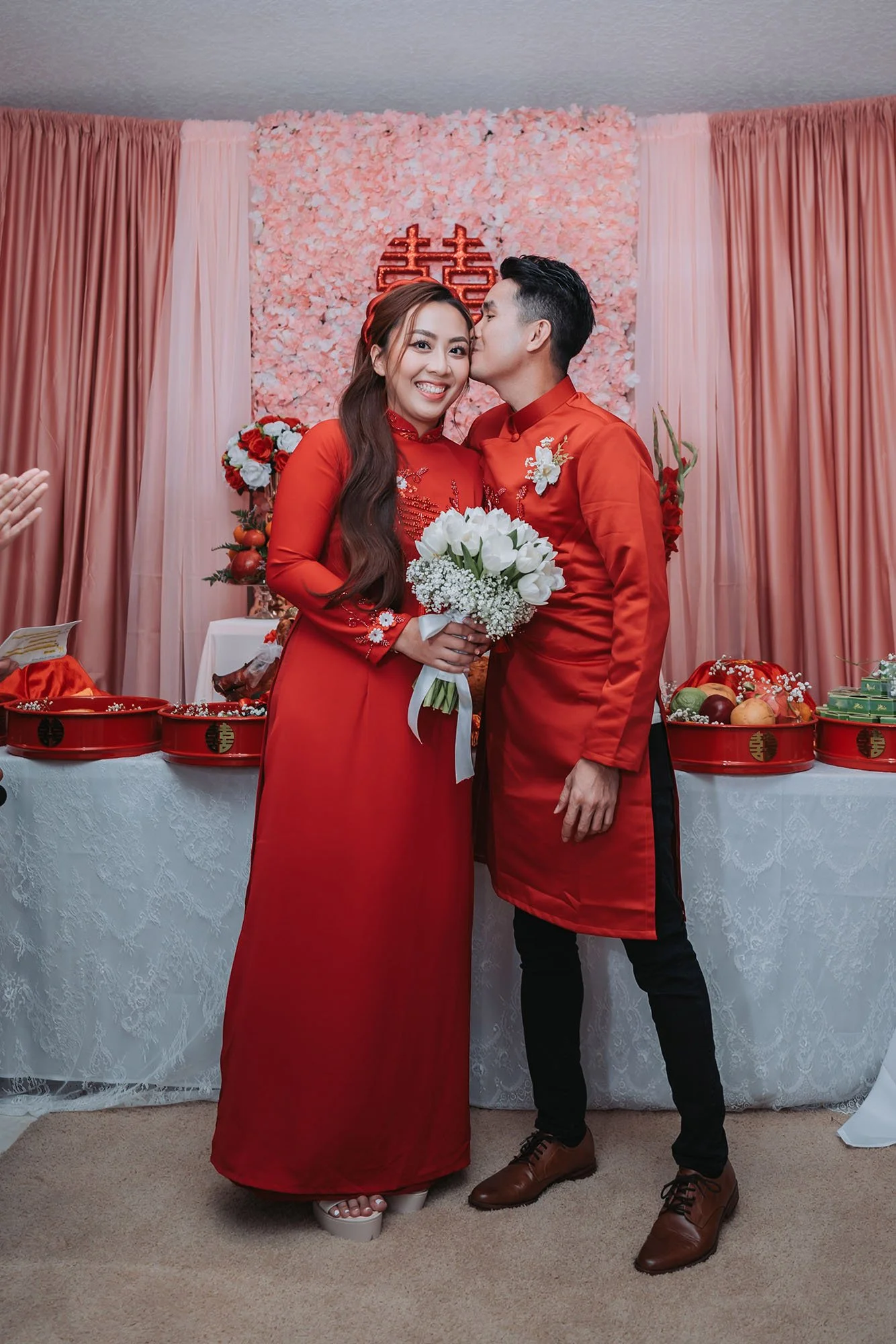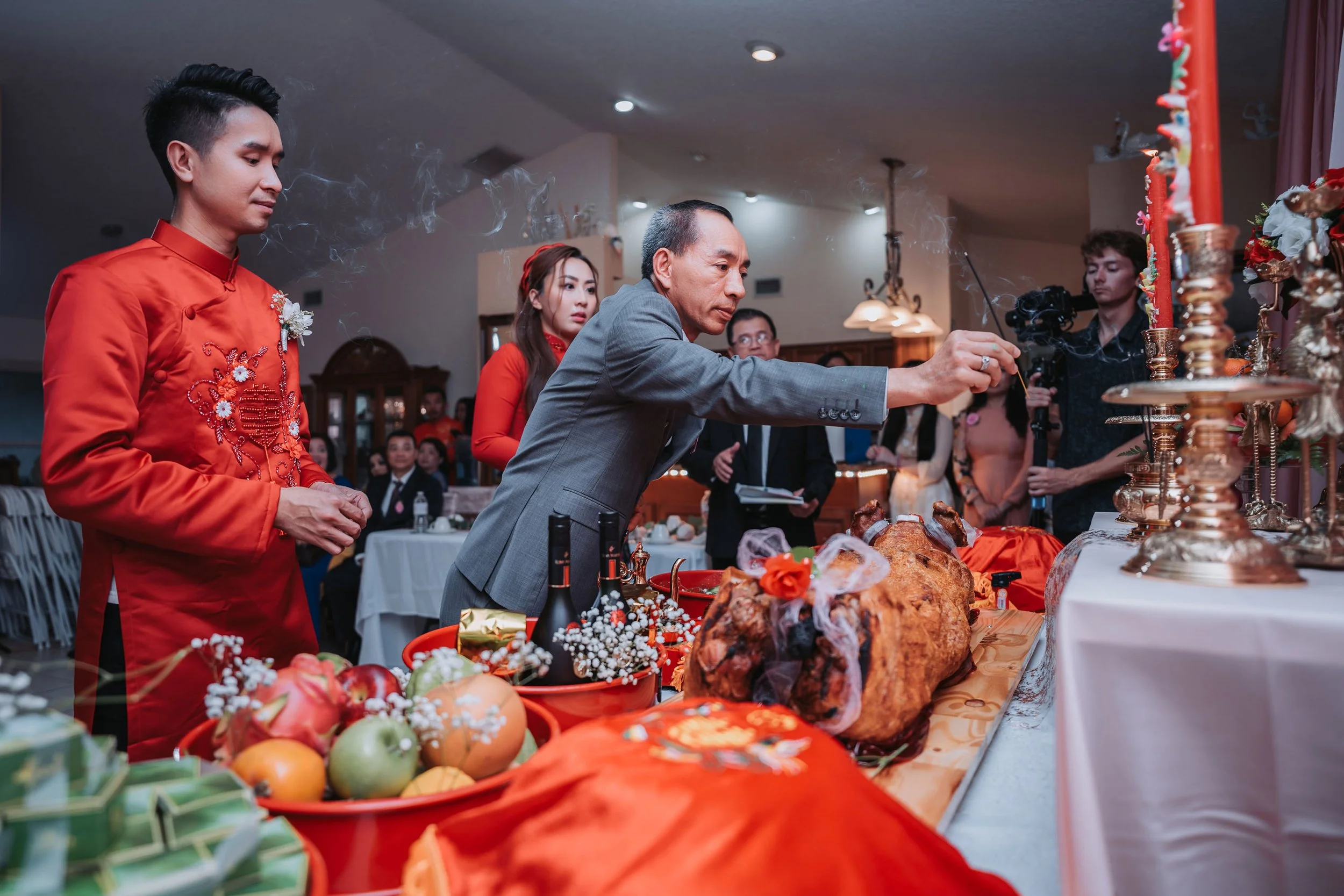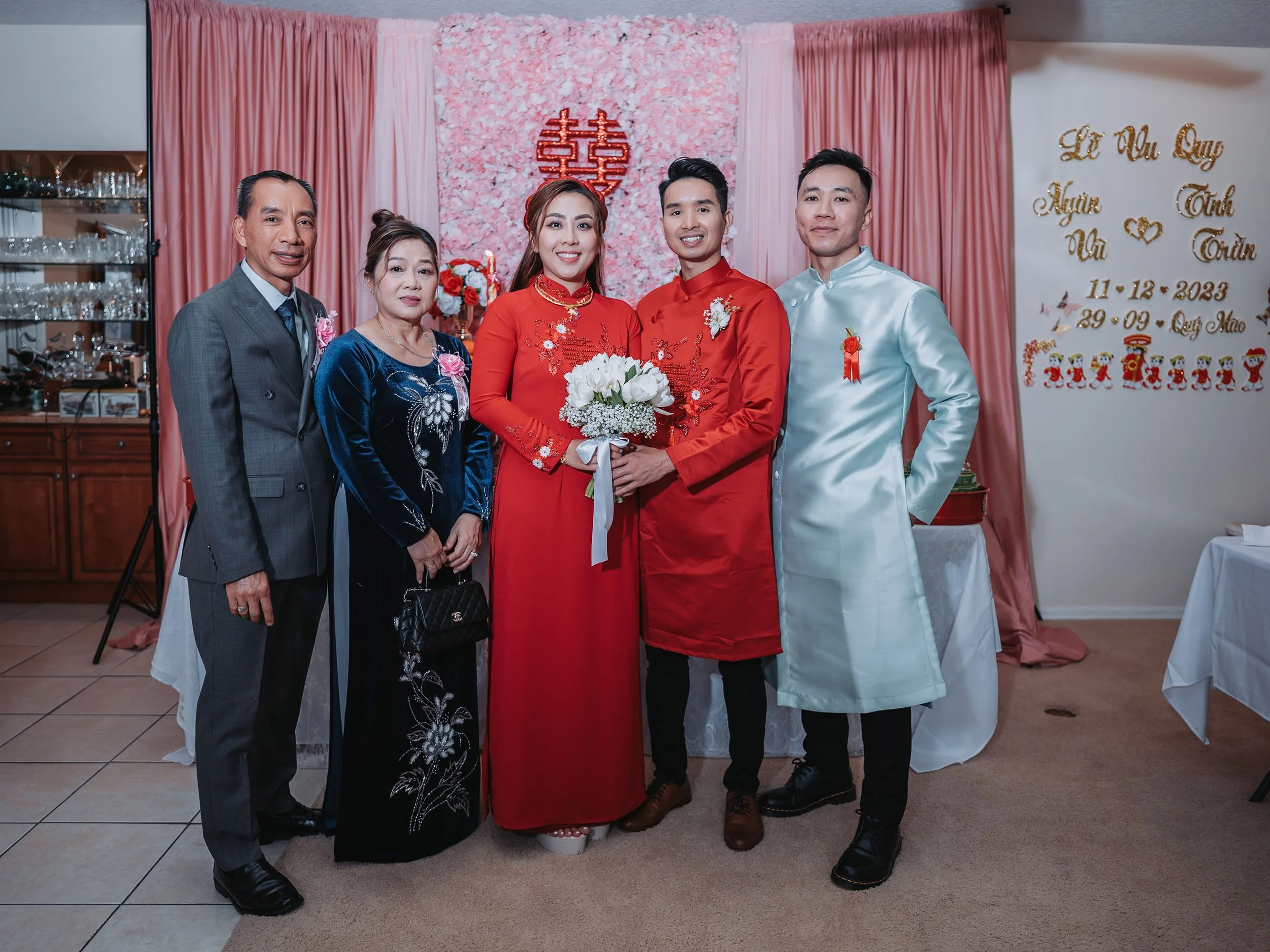What is a Tea Ceremony and How to Prepare for One?
Lễ Gia Tiên (Tea Ceremony) - in Vietnamese culture is a deeply symbolic and meaningful tradition, often held during weddings to honor family, ancestors, and the union of two families. It serves several important purposes: honoring ancestors, uniting families, expressing gratitude to parents and elders, symbolizing respect and humility, seeking blessings, and cultural continuity.
Lễ Đính Hôn (Engagement Ceremony) - the official engagement, where the groom’s family asks for the bride’s hand in marriage, formalizing the couple’s intention to marry. Though this ceremony is not as common as of late, unless both families are deeply traditional.
Lễ Vu Quy (Bride’s Departure Ceremony) - the bride’s family formally gives her away to the groom’s family. This ceremony begins with the groom and his family visiting the bride’s home, bringing gifts (mâm quả) as a formal request to marry their daughter. If the bride’s family accepts, the tea ceremony proceeds, during which the couple receives blessings and gifts from both sides of the family.
Lễ Tân Hôn (Wedding Ceremony at Groom’s Home) - following the ceremony at the bride’s home, it is customary for the bride to visit the groom’s family house. There, the groom’s mother will escort the bride into their home, symbolizing her official acceptance as their daughter-in-law.
However, in Western countries, many families choose to simplify the tradition by omitting the visit to the groom’s home due to time constraints and logistical reasons.
To summarize, Lễ Gia Tiên can take place during Lễ Đính Hôn, Lễ Vu Quy, and Lễ Tân Hôn. It is a significant ritual where families pay tribute to their ancestors, seeking blessings for the marriage. However, Lễ Gia Tiên is more commonly associated with Lễ Vu Quy and Lễ Tân Hôn rather than Lễ Đính Hôn, since Lễ Đính Hôn is mainly marking the couple’s intention to marry.
The Order of Events
The order of events during a traditional Vietnamese tea ceremony (Lễ Đính Hôn or Lễ Vu Quy):
Arrival of the Groom’s Family
The groom’s family arrives at the bride’s house with Mâm Quả (offering trays). A representative walks with another person holding a tray containing tea. The groom’s representative will meet the bride’s representative at the door and ask for permission to enter the house to begin the ceremony.
Exchange of Gifts
The bride’s family accepts the offerings. The bridesmaids are then lined up in front of the bride’s residence to accept gifts handed to them by the groomsmen. After photos and videos of the gift exchange are completed, the bridesmaids take the gifts inside the house and lay them on a table in front of the altar.
Introduction and Blessings
Both families introduce themselves. The bride’s mother or aunt escort her into the ceremony area from her holding place. The groom gifts her a bouquet of flowers. The eldest members give speeches and offer blessings for the couple’s future.
Tea Ceremony
The couple serves tea to parents and elders, symbolizing gratitude and respect. In return, they receive advice, blessings, and sometimes gifts (jewelry or money).
Engagement Ritual (Optional)
The couple may choose to exchange wedding bands at this time, unless they have an American Ceremony scheduled for a later date/time.
Ancestral Worship
The couple lights incense and prays at the family altar, asking for blessings from ancestors.
Celebration
Families celebrate with food, photos, and conversations, marking the unity between the two families.
Choosing the Right Date for Your Vietnamese Wedding
Selecting a date for your Vietnamese wedding often involves more than just availability. For many families, elders believe that auspicious dates bring harmony and prosperity, sometimes making the date non-negotiable. This can complicate booking venues or vendors, especially if they’re unavailable on the chosen day.
Combining Ceremonies to Save Costs
If possible, consider holding your tea ceremony and wedding reception on the same day. This saves money by reducing vendor bookings and simplifies logistics. However, if a church ceremony is part of your plans, it’s better to schedule the tea ceremony on a different day. This allows more time for photos and reduces the stress of rushing between events.
Finding the Balance
Honoring tradition while keeping things manageable is key. Whether you combine or separate ceremonies, careful planning ensures a joyful celebration that reflects your love and heritage.
Vietnamese Wedding Photographer in Tampa Florida
Are you looking for a Vietnamese photographer? We are located in Tampa, FL but are willing to travel for our couples!
What Are Gift Trays (Mâm Quả ) Usually Composed Of?
In a traditional Vietnamese engagement ceremony (Lễ Đính Hôn), the groom’s family presents gifts on trays called Mâm Quả to the bride’s family. These gifts symbolize respect, love, and good fortune. Common items include:
Betel Leaves and Areca Nuts (Trầu Cau) – Symbolize love, loyalty, and unity in marriage.
Tea and Wine (Trà và Rượu) – Represent respect and the joining of families.
Sticky Rice Cakes (Bánh Phu Thê) – Signify sweetness, fidelity, and a lasting marriage.
Fruits (Trái Cây) – Symbolize fertility, prosperity, and blessings.
Roasted Pig (Heo Quay) – Represents wealth, luck, and happiness.
Sweets (Bánh Kẹo) – Signify a joyful and sweet future.
Gold Jewelry (Trang Sức Vàng) – Symbolizes wealth, blessings, and stability.
Candles (Nến Long Phụng) – Represent balance and eternal love.
These offerings express the groom’s sincerity and the hope for a happy, prosperous marriage.
Have More Questions? Don’t Hesitate to Say Hi!
The Preparation
Traditionally, on the morning of the wedding day, the bride gets ready at her parent's house, while the groom gets ready at his. As part of the dowry or as symbols of wealth and luck, the groom's family prepares gifts, including items like a whole roast pig, fruits, cakes, and jewelry for the bride.
The Groom’s Arrival (10-15 minutes)
The groom, his family, and close friends will then make their way to the bride’s house. There, the groom’s representative, usually the parents or another elderly family member, will knock on the bride’s parent’s door and ask for permission to come in and receive the bride. Once the bride’s family has agreed, the bridesmaids will line up outside of the house to await the groomsmen to line up in front of them and to receive the gifts. Once gifts are exchanged, the bridesmaids will take the gifts into the house followed by the groom’s parents, the groom, close family members, and then the groomsmen. Since the tea ceremony is usually held in the living room, space is always limited, for this reason, the bridesmaids and groomsmen will for the most part stay in the back to give room for the immediate family members.
The Introductions (10 minutes)
The groom’s representative will begin by formally stating the purpose of their visit and introducing the groom’s family members. They may also present each gift (mâm quả) brought by the groom’s side, explaining the meaning and symbolism behind each item (though this part is optional). After the presentation, the bride’s family will express their acceptance of the gifts and proceed to introduce the members of the bride’s family, officially welcoming the groom’s side into their home.
The Formalities (10 minutes)
The fathers or designated representatives from both families will each light a candle and bow before the altar as a gesture of respect to the ancestors. Following this, the bride’s father will formally announce the entrance of the bride. At that moment, the bride’s mother will escort the bride from where she has been waiting to meet the groom and his family.
The representative from the bride’s side will then invite the couple to light incense and bow before the altar, symbolizing respect and a request for blessings from their ancestors. In some cases, the couple may also bow to their parents and then to each other as a sign of gratitude and respect.
The couple will proceed to exchange wedding rings during the ceremony. However, in certain instances, they may choose to exchange rings later during a church ceremony or a separate Western-style wedding.
The Tea Ceremony (20-30 minutes depending on the size of the families)
The best man holds the tea tray while the bride and groom carefully pour tea into two small cups. The couple then presents the tea, starting with the eldest family members, such as grandparents and parents from both sides. Once the tea is accepted and consumed, family members take the opportunity to offer gifts to the couple. Along with the gifts, they share words of encouragement, wisdom, and heartfelt congratulations, blessing the couple as they begin their new journey together.
The Family Portraits (10-20 minutes depending on size of the families)
Lining up in front of the altar or a decorative wall for photos is an absolute must in a Vietnamese wedding. You’d want to do this prior to releasing the family members to the reception. If space is limited, the outdoor is a great place for family group photos as well.
The Wedding Party and Groom and Bride Portraits
Not everyday do Vietnamese women dress up in the traditional Vietnamese Ao Dai, thus this is the perfect opportunity for photos.
The Lunch Reception
The tea ceremony concludes with a celebratory feast, allowing both the groom’s and bride’s families to socialize, bond, and enjoy each other’s company over delicious Vietnamese food and desserts. This shared meal symbolizes the union of the two families and marks the beginning of their new connection.
Tips for a Smooth Tea Ceremony
1. Altar Location:
Choosing the altar location is often important to parents and may not be flexible. It's usually placed in a small room, which can make it hard to fit both families. Some decorators suggest adding a table and chairs for elders to sit during the ceremony. While this looks nice, it can block photographers and videographers. A better option is to set up the table for initial photos, then move it aside during the ceremony to allow for full-body shots of the couple.
2. Decorations:
Don’t wait until the wedding morning to arrange the altar and tea ceremony space. Clear out unnecessary furniture beforehand to make room for guests. This allows the photographer to focus on capturing candid moments instead of rushing family members trying to decorate at the last minute.
3. Choose a Ceremony Leader:
Pick one person from each family to lead the tea ceremony. Make sure they know the order of events. Since parents may have different preferences, discuss the plan with them in advance and ensure both leaders are on the same page.
4. Good Posture Matters:
Stand tall during the ceremony – keep your back straight, chest up, and shoulders relaxed. Practice in front of a mirror to feel confident and look your best.
5. Jewelry for the Bride:
To avoid delays, have someone else put the bride’s jewelry on during the tea ceremony. The mother can then “pretend” to put the jewelry on for photos and videos. This prevents accidents, like dropping pieces and spending time searching for them.
6. Smile Often:
Remind yourself and your family to smile frequently. It’s easy to get distracted by tasks and forget to smile, but it makes a big difference in the photos.
7. Posing for Gifts:
When guests present gifts, encourage them to pause and pose for a photo with you. Assign someone to collect and hold envelopes so they aren’t visible in the pictures.
8. Photos Before Lunch:
Take family, wedding party, and couple portraits before the lunch reception. Once guests start eating, their outfits may wrinkle, and they may feel less excited about taking photos.
These simple steps will help ensure your tea ceremony runs smoothly and looks great in photos!


